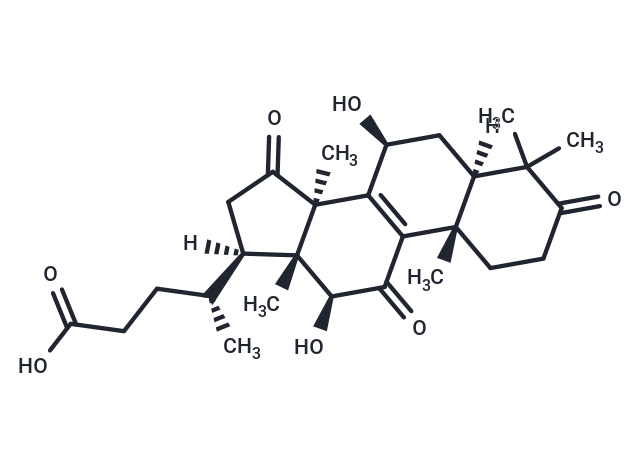Shopping Cart
- Remove All
 Your shopping cart is currently empty
Your shopping cart is currently empty

Lucidenic acid B (Lucidenicacid B), a natural compound extracted from Ganoderma lucidum, induces activation of caspase-9 and caspase-3 and cleavage of PARP, which can induce apoptosis in human leukemia cells through mitochondrial mediation. Lucidenic acid B inhibits PMA-induced invasion of human hepatocellular carcinoma cells by inactivating the MAPK/ERK signaling pathway and decreasing the binding activity of NF-kappaB and AP-1. Lucidenic acid B had no effect on cell cycle and necrotic cells.

| Pack Size | Price | Availability | Quantity |
|---|---|---|---|
| 1 mg | $163 | In Stock |
| Description | Lucidenic acid B (Lucidenicacid B), a natural compound extracted from Ganoderma lucidum, induces activation of caspase-9 and caspase-3 and cleavage of PARP, which can induce apoptosis in human leukemia cells through mitochondrial mediation. Lucidenic acid B inhibits PMA-induced invasion of human hepatocellular carcinoma cells by inactivating the MAPK/ERK signaling pathway and decreasing the binding activity of NF-kappaB and AP-1. Lucidenic acid B had no effect on cell cycle and necrotic cells. |
| In vitro | The effect of Lucidenic acids (A, B, C, and N) isolated from a new G. lucidum (YK-02) on the induction of cell apoptosis and the apoptotic pathway in HL-60 cells was investigated. The results demonstrated that Lucidenic acid B (LAB) did not affect the cell cycle profile; however, it increased the number of early and late apoptotic cells but not necrotic cells. Treatment of HL-60 cells with LAB caused loss of mitochondria membrane potential. Moreover, the ratio of expression levels of pro- and antiapoptotic Bcl-2 family members was changed by LAB treatment. LAB-induced apoptosis involved the release of mitochondria cytochrome c and subsequently induced the activation of caspase-9 and caspase-3, which were followed by cleavage of poly(ADP-ribose) polymerase (PARP).[1] |
| Alias | Lucidenicacid B |
| Molecular Weight | 474.59 |
| Formula | C27H38O7 |
| Cas No. | 95311-95-8 |
| Smiles | C[C@]12C3=C([C@]4(C)[C@@](C[C@@H]3O)(C(C)(C)C(=O)CC4)[H])C(=O)[C@@H](O)[C@]1(C)[C@@]([C@@H](CCC(O)=O)C)(CC2=O)[H] |
| Relative Density. | 1.27 g/cm3 (Predicted) |
| Storage | store at low temperature | Powder: -20°C for 3 years | In solvent: -80°C for 1 year | Shipping with blue ice. |

Copyright © 2015-2025 TargetMol Chemicals Inc. All Rights Reserved.